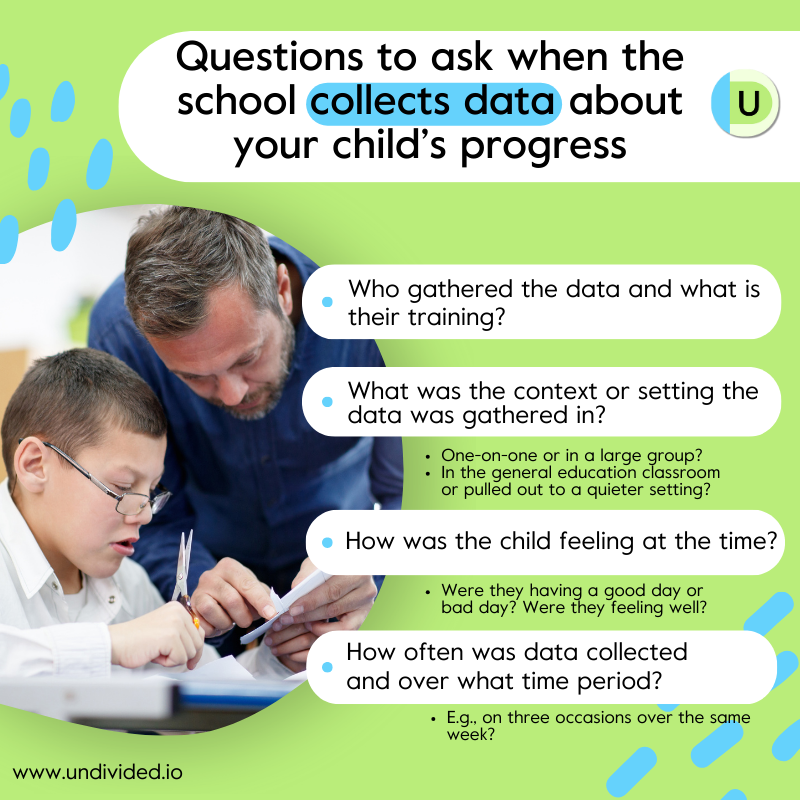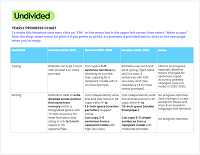Progress Reporting for IEPs
3 key takeaways
- Progress on annual IEP goals is reported on a regular basis and at every annual review, and it should include numerical data.
- When writing goals with your IEP team in your annual meeting, consider carefully how you want your child's progress to be measured and reported.
- If progress is not being made (or only partial progress), ask why your child is not making progress.
Every child with an IEP must have an annual review before the anniversary of their last annual or their initial IEP, and eligibility for an IEP must be determined every three years. The purpose of the annual meeting is to review progress on the previous year’s goals, as well as to develop new goals based on the current needs of the student. Given that there is no formal annual assessment, the needs of the student are determined by whether or not that student met the previous year’s goals, as well as additional insight from the team (including you, the parent).
A note on the integrity of collecting data
It’s important to keep in context that the data used in monitoring a child’s progress is only as good as the data gathering process. Data is gathered within the educational setting that the child is present, often by paraprofessionals with relatively little training. It’s always important to ask about the process:

Baselines and hard data
If there is no number attached to that goal, request it and be certain to request the data that was collected to track that goal.
The only way a goal can be marked as “partially met” is if there was improvement from the baseline. Make sure you have the previous year’s IEP with you so you can reference the baselines.
Compare the previous year or two to this year’s baselines to determine whether progress has been made. If not, question that: Why is your child’s progress stagnant? We’ve put together a Yearly Progress Chart for Undivided members to make it easier to compare baselines (with helpful examples, too!).
Present levels of performance (PLOP)
It’s very important to make sure your child’s present levels of performance (PLOP) page is detailed and precise. Present levels show needs, and needs drive goals and accommodations, which drive services. Collectively, this information is used to determine placement. Without clear, accurate, and detailed present levels, the entire IEP will not accurately reflect your child’s strengths and needs. It is critical that all areas within the academic sections are reported out and are accurate. If you have input, share it and make sure it is added.
Lisa Carey says, “You should be getting progress reports throughout the year. With progress reports, you can compare to the present levels and then also compare to a previous year's present levels, if this is your second or after IEP. It can help you show where the progress is. Also, it can help you catch if a provider or a teacher might not be tracking the data as well as you would like. For example, if in November your child can add two double digits, but in June, they can't do that anymore. So what happened? Was the data collected bad, or has the child regressed? If the child's regressed, why? I believe that when it comes to IEPs and educating our kids, there has to be a why. If you don't get to the why, you can't fix it. You have to know the why so you can figure out what to change.”
Adjusting unmet goals
For example, let’s say a student had the following goal:
Given a visual aid for focus, Rahim will remain engaged in small group activities for 15 consecutive minutes in 80% of opportunities per day, over 5 consecutive days.
If the goal was not met, the district cannot simply continue this goal as is or merely change the percentage (for example, to 70%). It’s possible that Rahim didn’t meet this goal because he needs more than a visual aid to be engaged. The goal needs to include whatever supports he may need, or we need to change the goal to better meet the need. If Rahim is overstimulated, the goal should focus on ways Rahim can implement sensory strategies to maintain engagement during small group instruction. Whatever the case, a discussion should be had. Do not let the district dictate that discussion and gloss over why the goal was not met.
When writing new annual goals with your IEP team, it is important to pay close attention to how, where, and when your child’s progress will be measured, which should be a part of each goal. In the IEP meeting, parents can request that goals be rewritten to adjust the way that progress is monitored. You can also request that progress reporting be provided more frequently than the standard report card intervals.
Between IEPs
Parents should receive regular progress reports throughout the school year, usually coinciding with the report cards sent out to all students. This may be three or four times a year depending on your school. Carefully review the progress being made on each IEP goal when you receive your progress report.
For children with extensive support needs, it is common to have short-term objectives (STO) or benchmarks that coincide with these reporting periods. If your child is meeting the STO, it is reassuring to know that progress is going as expected. Benchmarks can vary the target skill itself, building up to the annual goal, they can also fade supports such as prompts. If the benchmark only varies the percentage success rate, it's a waste of an opportunity to scaffold the skill development over the school year. You can find an example of using benchmarks effectively in our article Rewriting Goals for an IEP.
If your child is not making progress from the baseline or has not met the STO, contact the IEP team member with responsibility for that goal and ask them why they think progress is not being made. In some cases, you may need to request a meeting to adjust the goal. Remember that you can request an IEP meeting at any time, and the school has 30 days to hold one, but it does not always necessarily need to be a full IEP meeting. Amendments to the IEP can be made over the phone if you are in agreement.
Conversely, if your first progress report after the IEP shows that your child has already met all their annual goals, you should call an IEP meeting to agree to some more ambitious goals for the rest of the year.
For more great resources on progress reporting, check out Progress Reports: Myth Busting & Truth Talking on YouTube.
Join for free
Save your favorite resources and access a custom Roadmap.
Get StartedAuthor



